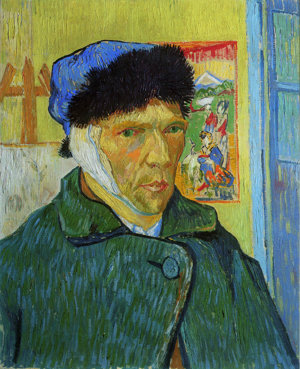Vincent van Gogh took his own life in July 1890. He felt sad and lonely. What happened?

Vincent van Gogh, Wheatfield with Crows, 1890
The beginning of the end
Vincent left the psychiatric clinic at Saint-Rémy near Arles in the south of France in May 1890, hoping to be able to live independently with his condition. He found a certain peace in the village of Auvers-sur-Oise near Paris, where he soon began to paint prolifically once more.
Sadly, it would not last. Two months after his arrival, Vincent shot himself in the chest. He died there on 29 July 1890.
‘Ah well, I risk my life for my own work and my reason has half foundered in it. But what can you do?’’
Final sentence of the unfinished letter to Theo, with a note in Theo’s hand: ‘The letter he had on him on 27 July, the day of the accident’.

Vincent van Gogh, Portrait of Doctor Gachet, 1890
In Auvers
Towards the end of his stay in the south of France, Vincent began to yearn for the north. He wanted to be closer to his brother Theo, who lived in Paris with his young family. Auvers-sur-Oise was a well-known artists’ village, roughly 30 kilometres from the French capital. There was also a doctor there, Paul Gachet, who could keep an eye on him.
Dr Gachet
Vincent met the doctor immediately after arriving on 20 May and paid regular visits to his home. Gachet did not offer the artist medical treatment, but talked to him at length and encouraged him to paint. Gachet was an art lover. He taught Vincent to etch, which is how this portrait came to be created.
‘I’ve seen Dr Gachet, who gave me the impression of being rather eccentric [...]’
Vincent to his brother Theo, 20 May 1890

Auberge Ravoux on the Place de la Mairie in Auvers-sur-Oise, with innkeeper Arthur Ravoux on the left, 1890
Auberge Ravoux
Vincent rented a small attic room at the Auberge Ravoux (Café de la Mairie) for three and a half francs a night. He used the ‘Painter’s Room’ downstairs to paint and to store his canvases.
The Ravoux family grew accustomed to him setting off each day to work in the surrounding countryside. On 27 July, he failed to return for his evening meal. Knowing Vincent’s punctuality when it came to dinner, they immediately began to worry...
The end
A badly wounded Vincent entered the inn around nine o’clock. When Ravoux asked what he had done, he replied: ‘I tried to kill myself’.
Theo was notified the following morning and rushed from Paris to the bedside, which he never left. Vincent was conscious and the brothers were able to converse. Theo later wrote to their mother: ‘Vincent said: I would so like to go, and an hour later he had his wish. Life weighed so heavily on him.’ Vincent died the following night.

Local newspaper report on Van Gogh’s self-inflicted gunshot wound and subsequent death. Archives départementales du Val-d’Oise, Pontoise
Sense of failure
Vincent himself stated that he had attempted to take his own life. The recently raised theory that he had been shot by schoolboys is entirely unfounded and can be dismissed.
Vincent’s letters indicate that his mental health had been deteriorating since the beginning of July. The sense of failure and fear that his life would never get better intensified, ‘[...] my life, too, is attacked at the very root, my step also is faltering’, he wrote.
Increasing loneliness, considerable uncertainty about the future and the idea that he was nothing but a burden to his brother Theo might have contributed to his suicide.

Vincent van Gogh, Tree Roots, 1890
‘I’d perhaps like to write to you about many things, but first the desire has passed to such a degree, then I sense the pointlessness of it.’
Vincent to his brother Theo, 23 July 1890

The graves of Vincent and Theo van Gogh in Auvers-sur-Oise
Funeral
The funeral cortège made its way from Auberge Ravoux to the churchyard at three o’clock on Wednesday 30 July, led by a grief-stricken Theo. He was followed by friends from Paris, the Ravoux family, neighbours and other villagers who had known Vincent in Auvers.
Van Gogh’s grave was close to the entrance of Auvers cemetery, ‘in a sunny spot amid the wheatfields’, Theo wrote to his wife Jo.
His remains were reinterred in 1905 and his brother Theo (deceased in 1891) was placed alongside him in 1914.

Part of Theo’s letter to his wife Jo, dated 1 August 1890, in which he writes about Vincent’s last words and his funeral.

Jo Bonger, ca. 1905
Legacy
In the weeks that followed, Theo and his family received numerous messages of support from artist friends, critics and collectors: evidence of how much Vincent’s talent was already appreciated and of what he had meant to them and to art.
‘He lives on for you, for us – and for everyone – in the works he left us’, one friend and artist wrote.
Vincent’s work was only known to a small circle at that point, but this would swiftly change after 1900, thanks to the efforts of an extraordinary woman, his sister-in-law Jo van Gogh-Bonger.
Vincent van Gogh had an eventful life. It wasn't always easy.
Do you have dark feelings or suicidal thoughts? It helps to talk. If you are in need of emotional support, find a helpline or hotline near you. Online chat, text, or phone. Free and confidential. Visit findahelpline.com.


